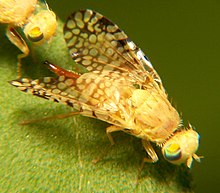Euaresta is a genus of flies in the family Tephritidae that live in plants of the closely related genera Ambrosia, Xanthium, and Dicoria, and feed on their flowers and seeds.[4][5][6]
| Euaresta | |
|---|---|

| |
| Euaresta aequalis | |
| Scientific classification | |
| Domain: | Eukaryota |
| Kingdom: | Animalia |
| Phylum: | Arthropoda |
| Class: | Insecta |
| Order: | Diptera |
| Family: | Tephritidae |
| Subfamily: | Tephritinae |
| Tribe: | Tephritini |
| Genus: | Euaresta Loew, 1873[1] |
| Type species | |
| Trypeta festiva Loew, 1872[1]
| |
| Synonyms | |
The 15 species of Euaresta are endemic to the Americas, eight being native to North America and seven to South America. Only one specimen has been collected in Central America (E. toba in El Salvador), and one or two species occur in the Antilles.[4]
Euaresta bullans has been introduced, perhaps accidentally, from South America to California and Arizona, southern Europe, the Middle East, South Africa and Australia, where it attacks spiny cocklebur (Xanthium spinosum). E. aequalis has been introduced to Fiji and Australia, to act as a biological control agent of common cocklebur (Xanthium strumarium). E. bella was released in Europe to control ragweed (Ambrosia artemisiifolia), but did not become established there.[4]
Species edit
Fifteen species are recognised in the genus Euaresta:[4]
|
|
References edit
- ^ a b c d e Loew, Hermann (1873). "Monographs of the Diptera of North America. Part III". Smithsonian Miscellaneous Collections. 11: vii + 351 +XIII pp., 4 pls. Retrieved 26 January 2021.
- ^ Hendel, Friedrich (1914). "Die Gattungen der Bohrfliegen. (Analytische Ubersicht aller bisher bekannten Gattungen der Tephritinae.)". Wiener Entomologische Zeitung. 33: 73–98. Retrieved 8 February 2021.
- ^ Benjamin, F.H. (1934). "Descriptions of some native trypetid flies with notes on their habits". Technical Bulletin, United States Department of Agriculture. 401: 1–95.
- ^ a b c d Allen L. Norrbom (January 26, 2001). "Euaresta Loew (Diptera: Tephritidae)". The Diptera Site. Agricultural Research Service. Archived from the original on July 9, 2010. Retrieved July 31, 2010.
- ^ Norrbom, A.L.; Carroll, L.E.; Thompson, F.C.; White, I.M; Freidberg, A. (1999). "Systematic Database of Names. Pp. 65-252. In Thompson, F. C. (ed.), Fruit Fly Expert Identification System and Systematic Information Database". Myia. 9: vii + 524.
- ^ Foote, Richard H.; Blanc, P.L.; Norrbom, Allen L. (1993). Handbook of the Fruit Flies (Diptera: Tephritidae) of America North of Mexico. New York: Cornell University Press (Comstock Publishing). pp. xii, 571. ISBN 9780801426230.
- ^ Snow, W.A. (1894). "Descriptions of North American Trypetidae, with notes. Paper I". The Kansas University Quarterly. 2: 159–174, 2 pls.
- ^ Curran, Charles Howard (1932). "New species of Trypaneidae, with key to the North American genera" (PDF). American Museum Novitates. 556: 1–19. Retrieved 9 February 2021.
- ^ a b Coquillett, Daniel William (1894). "New North American Trypetidae". The Canadian Entomologist. 26: 71–75. Retrieved 9 February 2021.
- ^ Coquillett, D.W. (1902). "New acalyptrate Diptera from North America". Journal of the New York Entomological Society. 10: 177–191. Retrieved 9 February 2021.
- ^ Wiedemann, Christian R. W. (1830). Aussereuropaische zweiflugelige Insekten. Vol. 2. Hamm: Zweiter Theil. Schulz. pp. xii + 684 pp., 5 pls. Retrieved 21 April 2020.
- ^ Aczél, M.L. (1952). "El genero Euaresta Loew (=Camaromyia Hendel) en la region neotropical". Revista Chilena de Entomología. 2: 147–172. Retrieved 10 February 2021.
- ^ a b Hendel, F. (1914). "Die Bohrfliegen Sudamerikas". Abhandlungen und Berichte des Königl. Zoologischen und Anthropologisch-Etnographischen Museums zu Dresden. (1912)14: 1–84, 4 pls.
- ^ a b Norrbom, A.L. (1993). "New species and phylogenetic analysis of Euaresta Loew (Diptera: Tephritidae) with a key to the species from the Americas south of Mexico". Proceedings of the Entomological Society of Washington. 95: 195–209. Retrieved 10 February 2021.
- ^ Lindner, E. (1928). "Die Ausbeute der Deutschen Chaco-Expedition. Diptera. Einleitung, I. Trypetidae und II. Pterocallidae". Konowia. 7: 24–36.